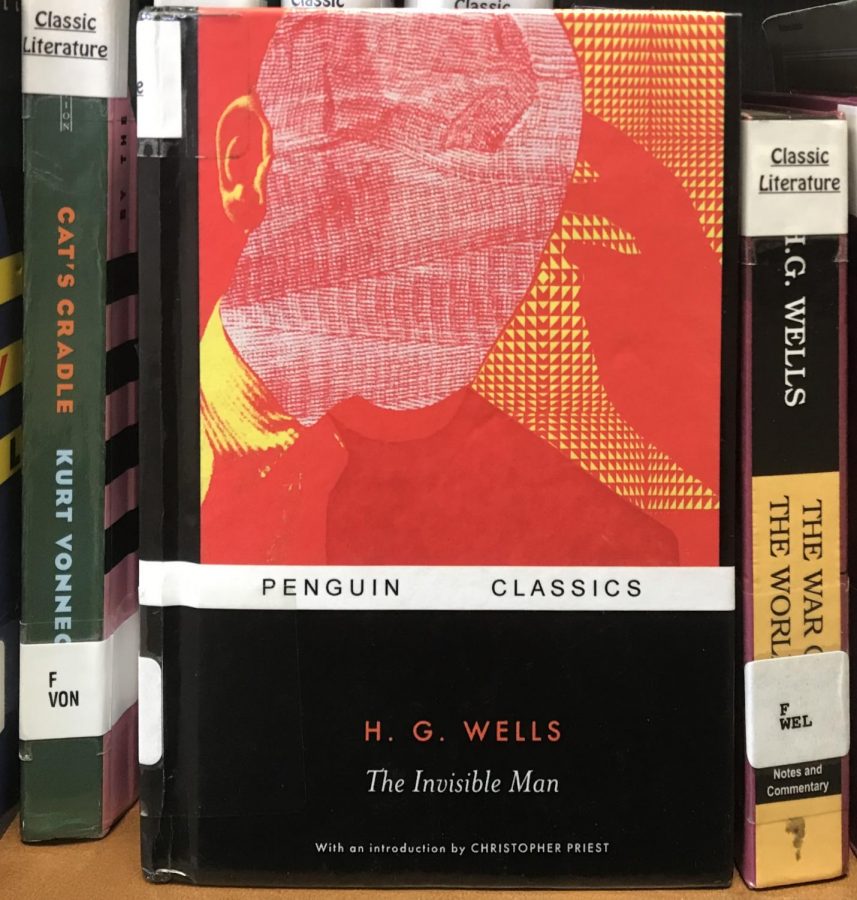“Invisible Man” movie review
The LHS library is home to the original book upon which this movie is based: “The Invisible Man” by H.G. Wells.
March 10, 2020
On Friday, Feb. 28, 2020, sci-fi mystery movie “Invisible Man,” a loose modern adaptation of H.G. Wells’ classic story, debuted in theaters.
This wonderful movie opens with beautiful yet mysterious shots of waves crashing upon a rocky beach shore in the dead of night. We soon follow protagonist Cecilia (Elisabeth Moss) as she escapes from whom she later deems her abusive husband Adrian Griffin (Oliver Jackson-Cohen), a wealthy optics entrepreneur. Cecilia stays with her friend and his daughter at a place only they would know about. Strangely, she receives a letter in the mail with her name stating her husband has committed suicide and that she could potentially inherit his $5 million estate, provided she meets certain legal conditions. Managing Adrian’s estate is his brother Tom Griffin (Michael Dorman). Soon, despite her husband’s death, Cecilia begins to believe Adrian is following and trying to terrorize her. When the police do not believe her, Cecilia decides to take matters into her own hands.
For the entire first fifteen minutes of the film, there is no dialogue. It simply is not necessary, as the exposition shots set up a unique and mysterious tone documenting Cecilia’s quiet escape. The reasons, motives, causes and effects are all unknown. To top it off, this masterful slow-burn scene of suspense occurs in the middle of the night, which contributes even more to the growing tension.
The rest of the movie is also a treat to watch. This is particularly true of the directing style via its camera angles. We often see events unfold from an unknown omniscient first person point of view, almost as if we are seeing the area through Griffin’s invisible eyes. The acting is also nearly flawless, especially with Moss, who masterfully portrays Cecilia’s archetype. Near the beginning, Cecilia is quiet and afraid to even go outside. She feels hunted and trapped by her allegedly dead husband. But by the end, the hunted becomes the hunter, and the hunter is soon hunted. All of her interactions with Adrian culminate in what feels like a mix between “The Terminator,” “Kill Bill” and a Jordan Peele movie.
We see this Invisible Man make Cecilia go crazy, to the point where she is arrested and placed into a mental health facility, depriving her of the $5 million estate she was likely never going to get. The Invisible Man, who Cecilia believes is Adrian, does this numerous times. One particularly memorable scene was where Cecilia was at a restaurant explaining to her sister what she discovered when she returned to her and Adrian’s house. Strangely, a knife moved from the table ‘on its own,’ slit her sister’s throat, and was then placed into Cecilia’s hand, framing her. We find ourselves siding with Cecilia time after time again, but eventually this rationale comes increasingly into question.
This particular character dynamism is most evident in the ending scene. Cecilia returns to her house for a meal with Adrian, who police found locked in a room and gagged (though Cecilia believes this was his own doing). This comes after a surprising twist reveals who the now allegedly dead Invisible Man really is. Adrian repeatedly denies his involvement in the alleged harassment of Cecilia. Though Adrian bears some verbal inflections similar to those of the Invisible Man, indicating they might be the same person, we soon see Cecilia seemingly believe Adrian in his admission of no wrongdoing. Our belief in Adrian’s innocence is further confirmed by his untimely death similar to how Cecilia’s sister died, at the hands of the Invisible Man (or did she?). Adrian unwillingly slits his own throat, as if someone invisible is forcing him to. While this scene makes one ponder who the Invisible Man was before and then, the very final seconds of the film do perhaps provide an answer.
Not only is the plot great and suspenseful, but there is also a plethora of deep symbolism to be unearthed. First, there is the obvious question of who is good and who is evil. Determining who to trust in a movie like this proves perhaps surprisingly difficult; for example, how does Adrian’s brother play into this? Also, one must consider that, even though Adrian might be dead by the film’s end, he might have still won. The kind, compassionate Cecilia from the beginning of the movie is now gone, with blood on her hands and a detached outlook after her sister’s death. We must ask ourselves, is this what Adrian really wanted? Furthermore, throughout the movie, Cecilia dons a Cal Poly Architecture sweatshirt. Architecture is all about building walls and protecting oneself from harsh outside forces. Meanwhile, her husband is head of an optics company, the goal of which is the opposite: to see what one previously could not and to expand one’s prying eyes. Even Adrian’s occupation is a microcosm of his treatment of Cecilia. Lastly, one of the characters, Sydney, also wears a jellyfish shirt. This is a powerful symbol. Some jellyfish, such as the Irukandji, can actually turn themselves invisible. In other words, they are toxic beings capable of hiding behind their ability of invisibility, just like Adrian.
Overall, lots can be said about ‘Invisible Man,” all of it good. This movie is a clear must-see with deep symbolism and a suspenseful plot that truly makes its audience ponder on the nature of the innocent, the evil and the unseen.









